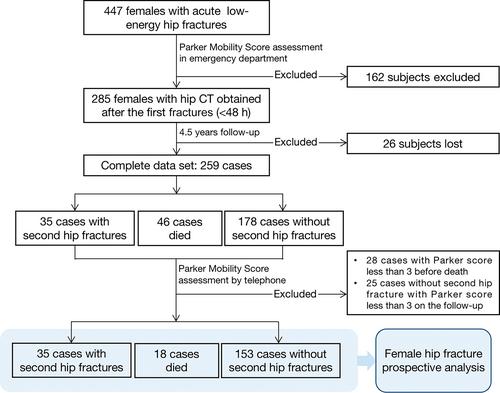Associations of Quantitative and Qualitative Muscle Parameters With Second Hip Fracture Risk in Older Women: A Prospective Cohort Study
IF 3.4
Q2 ENDOCRINOLOGY & METABOLISM
Wenshuang Zhang, Yufeng Ge, Yandong Liu, Yi Yuan, Jian Geng, Fengyun Zhou, Pengju Huang, Jia Shi, Kangkang Ma, Zitong Cheng, Glen M. Blake, Minghui Yang, Xinbao Wu, Xiaoguang Cheng, Ling Wang
{"title":"Associations of Quantitative and Qualitative Muscle Parameters With Second Hip Fracture Risk in Older Women: A Prospective Cohort Study","authors":"Wenshuang Zhang, Yufeng Ge, Yandong Liu, Yi Yuan, Jian Geng, Fengyun Zhou, Pengju Huang, Jia Shi, Kangkang Ma, Zitong Cheng, Glen M. Blake, Minghui Yang, Xinbao Wu, Xiaoguang Cheng, Ling Wang","doi":"10.1002/jbm4.10834","DOIUrl":null,"url":null,"abstract":"<p>Older women with a first hip fracture exhibit heightened susceptibility and incidence of second fracture and potentially severe consequences. This prospective study was to compare the predictive power of qualitative and quantitative muscle parameters for a second hip fracture in older women with a first hip fracture. A total of 206 subjects were recruited from the longitudinal Chinese Second Hip Fracture Evaluation study. Hip computed tomography (CT) scans were obtained immediately after the first fracture. Muscle fat infiltration was assessed according to the Goutallier classification qualitatively. Quantitative parameters included cross-sectional area and density of gluteus maximus (G.MaxM) and gluteus medius and minimus (G.Med/MinM) muscles. CT X-ray absorptiometry was used to measure the areal bone mineral density (aBMD) of the contralateral femur. Cox proportional hazards models were used to compute hazard ratios (HR) of second hip fracture risk. The mean age of subjects was 74.9 (±9.5) years at baseline. After 4.5 years, 35 had a second hip fracture, 153 without a second hip fracture, and 18 died. Except for the combined G.MinM Goutallier grade 3 and 4 groups before adjustment for covariates (HR = 5.83; 95% confidence interval [CI] 1.49–22.83), there were no significant HRs for qualitative classification to predict a second hip fracture. Among quantitative metrics, after adjustment for covariates, G.Med/MinM density was significant in the original (HR = 1.44; CI 1.02–2.04) and competing risk analyses (HR = 1.46; CI 1.02–2.07). After additional adjustment for femoral neck (FN) aBMD, G.Med/MinM density remained borderline significant for predicting a second hip fracture in competing risk analysis (HR = 1.43; CI 0.99–2.06; <i>p</i> = 0.057). Our study revealed that Goutallier classification was less effective than quantitative muscle metrics for predicting hip second fracture in this elderly female cohort. After adjustment for FN aBMD, G.Med/MinM density is a borderline independent predictor of second hip fracture risk. © 2023 The Authors. <i>JBMR Plus</i> published by Wiley Periodicals LLC on behalf of American Society for Bone and Mineral Research.</p>","PeriodicalId":14611,"journal":{"name":"JBMR Plus","volume":"7 12","pages":""},"PeriodicalIF":3.4000,"publicationDate":"2023-10-25","publicationTypes":"Journal Article","fieldsOfStudy":null,"isOpenAccess":false,"openAccessPdf":"https://asbmr.onlinelibrary.wiley.com/doi/epdf/10.1002/jbm4.10834","citationCount":"0","resultStr":null,"platform":"Semanticscholar","paperid":null,"PeriodicalName":"JBMR Plus","FirstCategoryId":"1085","ListUrlMain":"https://onlinelibrary.wiley.com/doi/10.1002/jbm4.10834","RegionNum":0,"RegionCategory":null,"ArticlePicture":[],"TitleCN":null,"AbstractTextCN":null,"PMCID":null,"EPubDate":"","PubModel":"","JCR":"Q2","JCRName":"ENDOCRINOLOGY & METABOLISM","Score":null,"Total":0}
引用次数: 0
Abstract
Older women with a first hip fracture exhibit heightened susceptibility and incidence of second fracture and potentially severe consequences. This prospective study was to compare the predictive power of qualitative and quantitative muscle parameters for a second hip fracture in older women with a first hip fracture. A total of 206 subjects were recruited from the longitudinal Chinese Second Hip Fracture Evaluation study. Hip computed tomography (CT) scans were obtained immediately after the first fracture. Muscle fat infiltration was assessed according to the Goutallier classification qualitatively. Quantitative parameters included cross-sectional area and density of gluteus maximus (G.MaxM) and gluteus medius and minimus (G.Med/MinM) muscles. CT X-ray absorptiometry was used to measure the areal bone mineral density (aBMD) of the contralateral femur. Cox proportional hazards models were used to compute hazard ratios (HR) of second hip fracture risk. The mean age of subjects was 74.9 (±9.5) years at baseline. After 4.5 years, 35 had a second hip fracture, 153 without a second hip fracture, and 18 died. Except for the combined G.MinM Goutallier grade 3 and 4 groups before adjustment for covariates (HR = 5.83; 95% confidence interval [CI] 1.49–22.83), there were no significant HRs for qualitative classification to predict a second hip fracture. Among quantitative metrics, after adjustment for covariates, G.Med/MinM density was significant in the original (HR = 1.44; CI 1.02–2.04) and competing risk analyses (HR = 1.46; CI 1.02–2.07). After additional adjustment for femoral neck (FN) aBMD, G.Med/MinM density remained borderline significant for predicting a second hip fracture in competing risk analysis (HR = 1.43; CI 0.99–2.06; p = 0.057). Our study revealed that Goutallier classification was less effective than quantitative muscle metrics for predicting hip second fracture in this elderly female cohort. After adjustment for FN aBMD, G.Med/MinM density is a borderline independent predictor of second hip fracture risk. © 2023 The Authors. JBMR Plus published by Wiley Periodicals LLC on behalf of American Society for Bone and Mineral Research.

定量和定性肌肉参数与老年妇女第二次髋部骨折风险的关系:前瞻性队列研究
首次髋部骨折的老年妇女更容易发生第二次骨折,并可能造成严重后果。这项前瞻性研究旨在比较肌肉定性和定量参数对首次髋部骨折老年妇女第二次髋部骨折的预测能力。该研究从中国第二次髋部骨折纵向评估研究中招募了 206 名受试者。首次骨折后立即进行髋部计算机断层扫描(CT)。根据 Goutallier 分类法对肌肉脂肪浸润进行定性评估。定量参数包括臀大肌(G.MaxM)、臀中肌和臀小肌(G.Med/MinM)的横截面积和密度。CT X 射线吸收测量法用于测量对侧股骨的骨矿密度(aBMD)。Cox比例危险模型用于计算第二次髋部骨折风险的危险比(HR)。基线受试者的平均年龄为 74.9 (±9.5) 岁。4.5 年后,35 人再次发生髋部骨折,153 人未再次发生髋部骨折,18 人死亡。除G.MinM Goutallier 3级和4级合并组在调整协变量(HR = 5.83;95% 置信区间 [CI] 1.49-22.83)之前,定性分类预测第二次髋部骨折的HR无显著性差异。在定量指标中,对协变量进行调整后,G.Med/MinM 密度在原始分析(HR = 1.44;CI 1.02-2.04)和竞争风险分析(HR = 1.46;CI 1.02-2.07)中具有显著性。在对股骨颈(FN)aBMD进行额外调整后,在竞争风险分析中,G.Med/MinM密度对预测第二次髋部骨折仍具有边缘显著性(HR = 1.43; CI 0.99-2.06; p = 0.057)。我们的研究表明,在这一老年女性队列中,Goutallier 分类在预测髋部二次骨折方面的效果不如定量肌肉指标。在对 FN aBMD 进行调整后,G.Med/MinM 密度是第二次髋部骨折风险的边缘独立预测指标。© 2023 作者。JBMR Plus 由 Wiley Periodicals LLC 代表美国骨与矿物质研究学会出版。
本文章由计算机程序翻译,如有差异,请以英文原文为准。


 求助内容:
求助内容: 应助结果提醒方式:
应助结果提醒方式:


